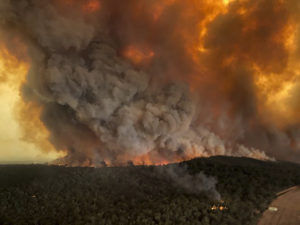An Even Quicker Death for the Great Barrier Reef?
As if climate change weren't destroying the natural wonder quickly enough, the Australian government's approval for construction of one of the world's largest coal ports will involve dumping 3 million cubic meters of earth drudged from the ocean floor into the Great Barrier Reef World Heritage Area.
As if climate change weren’t destroying the natural wonder quickly enough, the Australian government’s approval for construction of one of the world’s largest coal ports will involve dumping 3 million cubic meters of earth drudged from the ocean floor into the Great Barrier Reef World Heritage Area.
“To give you an idea of the scale of this dredging,” Greenpeace Australia director Alexander White writes at The Guardian, “if all of the spoil was put into dump trucks, there would be 150,000 of them lined up bumper to bumper from Brisbane to Melbourne.”
Of the consequences to marine life in the local ecosystem, White continues:
Just around the corner from the port is a beach that is the nesting place for endangered green and flat back turtles. Fun facts about the flat back turtle: they’re officially classified as “vulnerable” by the Australian Government, and nest only in northern Australia. They have the smallest migratory range of any marine turtle, so when their home in Queensland is destroyed, they’ve really got nowhere else to go.
Also in the spoil-dumping area are sea-grass beds, which are the home to dugongs. The “sea cows” may not be the sexiest of marine animals, but they are at risk of extinction, and most of the world’s remaining population lives in the Great Barrier Reef. This is one of the reasons that the Reef has World Heritage listing.
An independent government report from August this year found that dredging sediment travelled a lot further than previously thought. The risks include sediment being disturbed by severe weather. Even a cursory look at Queensland’s weather patterns near the Reef over the past decade would show that severe weather, including tropical cyclones and flooding, is a regular occurrence, even if you disregard massively destructive events like Cyclone Yasi.
Additionally, the export terminal will increase Australia’s profile as one of earth’s murderers by fossil fuel:
The Abbot Point development has been green-lit to funnel vast amounts of coal out of Australia. The coal ports currently proposed, including Abbot Point and new coal terminals proposed at Wiggins Island, Raglan Creek, Balaclava Island, Dudgeon Point, and Cape York, would increase total coal tonnage by more than six-fold, from 156 Mt in 2011 to a capacity of 944 Mt by the end of the decade.
Australia’s coal is one of the globe’s fourteen carbon bombs. Our coal export industry is the largest in the world, and results in 760m tonnes of CO2 emissions annually. The urgent goal of Tony Abbott’s government, and his environment minister Greg Hunt is to ship as much climate-devastating coal as possible, as quickly as possible.
Read more here.
— Posted by Alexander Reed Kelly.
Your support matters…Independent journalism is under threat and overshadowed by heavily funded mainstream media.
You can help level the playing field. Become a member.
Your tax-deductible contribution keeps us digging beneath the headlines to give you thought-provoking, investigative reporting and analysis that unearths what's really happening- without compromise.
Give today to support our courageous, independent journalists.






You need to be a supporter to comment.
There are currently no responses to this article.
Be the first to respond.